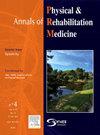虚拟现实治疗对青少年运动康复疼痛缓解的影响:系统回顾和荟萃分析
IF 4.6
3区 医学
Q1 REHABILITATION
Annals of Physical and Rehabilitation Medicine
Pub Date : 2025-03-12
DOI:10.1016/j.rehab.2025.101949
引用次数: 0
摘要
虚拟现实是一项旨在提高运动和感知认知技能的新兴技术,这可能使运动损伤患者受益。然而,缺乏对其在青少年运动损伤康复中的有效性的meta分析。本研究对随机对照试验进行了系统回顾和荟萃分析,评估了虚拟现实治疗(VRT)在年轻人运动相关肌肉骨骼康复中减轻疼痛、改善功能水平和平衡方面的有效性。方法通过PubMed、CINAHL、EMBASE、CENTRAL、Web of Science、Scopus、b谷歌Scholar、ProQuest Dissertation and Theses等灰色文献检索和人工检索文献列表,检索相关研究和综述。截至2024年3月19日发表的研究包括18-40岁的运动相关损伤的年轻人接受VRT。比较者为常规康复。采用随机效应模型,通过汇总疼痛、功能水平和平衡结果的标准化平均差异(SMD)或平均差异(MD)进行meta分析。质量评价采用Cochrane偏倚风险工具和推荐、评估、发展和评价分级(GRADE)进行。结果纳入6项研究(n = 507名受试者)。VRT在改善干预后疼痛方面(综合SMD -5.16, 95% CI -7.36至-2.97)和长期随访(综合SMD -10.08, 95% CI -12.46至-8.01)似乎明显优于传统疗法。然而,使用星偏移平衡测试测量的功能水平和平衡的结果不显著。5项试验偏倚风险低,3项偏倚风险高,3项偏倚风险不明确。结果的确定性非常低到低。结论vrt似乎能够显著改善运动相关肌肉骨骼损伤的年轻成年人的疼痛。治疗师和临床医生可以考虑将VRT纳入康复中,以吸引参与者并改善结果。关于VRT对功能和平衡的影响的研究有限。本文章由计算机程序翻译,如有差异,请以英文原文为准。
Effect of virtual reality therapy on pain relief in sports rehabilitation for young adults: A systematic review and meta-analysis
Background
Virtual reality is an emerging technology that intends to promote motor and perceptual-cognitive skills, which could benefit people with sports injuries. However, there is a lack of meta-analyses on its effectiveness in sports injury rehabilitation for young adults.
Objective
This systematic review and meta-analysis of randomised controlled trials evaluated the effectiveness of virtual reality therapy (VRT) on sports-related musculoskeletal rehabilitation in reducing pain and improving functional levels and balance among young adults.
Methods
Studies and relevant reviews were searched using PubMed, CINAHL, EMBASE, CENTRAL, Web of Science, Scopus, grey literature in Google Scholar, ProQuest Dissertation and Theses, and manual searching of reference lists. Studies published up to 19 March 2024 involving young adults aged 18–40 with sports-related injuries undergoing VRT were included. The comparator was conventional rehabilitation. Meta-analysis was done by pooling standardised mean differences (SMD) or mean differences (MD) of pain, functional levels, and balance outcomes using the random-effects model. Quality appraisal was done using the Cochrane Risk of Bias Tool and Grading of Recommendations, Assessment, Development, and Evaluations (GRADE).
Results
Eleven studies (n = 507 participants) were included. VRT seems significantly superior to conventional therapy in improving pain post-intervention (pooled SMD -5.16, 95% CI -7.36 to -2.97) and at long-term follow-up (pooled SMD -10.08, 95% CI -12.46 to -8.01). However, outcomes for functional levels and balance measured using the Star Excursion Balance Test were non-significant. Five trials had a low risk of bias, 3 were at high risk, and 3 had an unclear risk of bias. Outcomes were of very low to low certainty.
Conclusion
VRT seems able to significantly improve pain among young adults with sports-related musculoskeletal injuries. Therapists and clinicians can consider incorporating VRT in rehabilitation to engage participants and improve outcomes. Limited research has investigated the effect of VRT on function and balance.
求助全文
通过发布文献求助,成功后即可免费获取论文全文。
去求助
来源期刊

Annals of Physical and Rehabilitation Medicine
Medicine-Rehabilitation
CiteScore
7.80
自引率
4.30%
发文量
136
审稿时长
34 days
期刊介绍:
Annals of Physical and Rehabilitation Medicine covers all areas of Rehabilitation and Physical Medicine; such as: methods of evaluation of motor, sensory, cognitive and visceral impairments; acute and chronic musculoskeletal disorders and pain; disabilities in adult and children ; processes of rehabilitation in orthopaedic, rhumatological, neurological, cardiovascular, pulmonary and urological diseases.
 求助内容:
求助内容: 应助结果提醒方式:
应助结果提醒方式:


